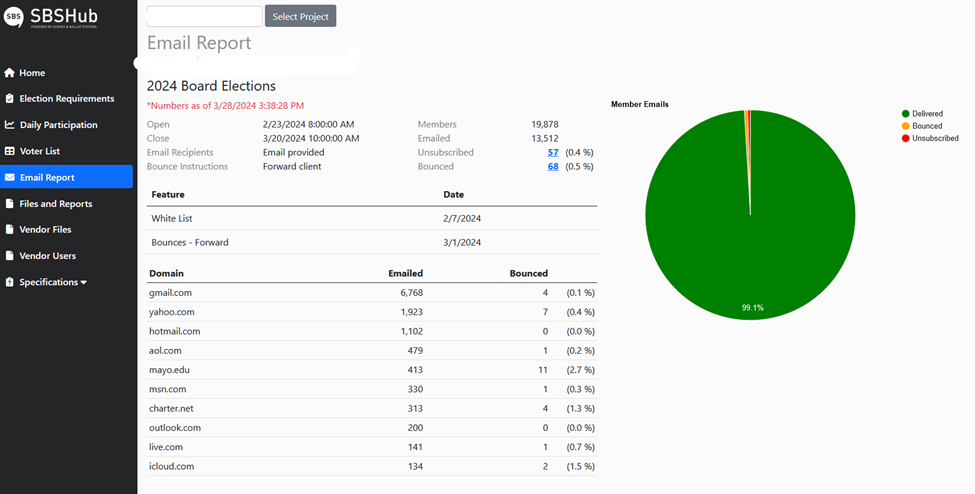Combatting Email Deliverability Issues
Email is vital for staying connected in our personal and professional lives. In 2024, the volume of emails exchanged is projected to surpass 361 billion, yet only 20 to 50 percent of these emails will actually be opened.
Despite email’s ubiquity, deliverability issues can undermine your communications’ effectiveness, causing significant disruption to your marketing and member engagement efforts. After all, if your emails don’t arrive in a member’s inbox, how can they engage with your organization?
Whether your voting reminders go straight to the spam folder or your weekly member newsletter is lost in no-man’s land, deliverability issues are urgent and must be addressed ASAP. In this guide, we’ll cover common deliverability issues and share three helpful email deliverability best practices to ensure your messaging reaches a wider audience.
Email Delivery vs Deliverability: What’s the Difference?
Before we look at common deliverability issues, it’s important to distinguish email delivery versus deliverability.
Email delivery refers to whether an email arrives at the recipient’s email server. It doesn’t guarantee that the email is actually in their inbox—just that the server didn’t reject it or bounce it back. It’s the first hurdle an email needs to clear to reach the recipient. A successful delivery could mean the server accepted the email, but depending on the filtering process, it still might end up in the spam folder.
Email deliverability, on the other hand, measures the likelihood of an email reaching the server and landing in the recipient’s inbox. Many factors affect deliverability, including:
- Engagement metrics from previous emails
- Sender reputation
- Adherence to spam filtering rules
Both delivery and deliverability matter, but deliverability is the best metric to track to ensure members received your message. Deliverability is about the quality of the delivery—ensuring that emails reach the inbox as intended rather than being diverted to junk or spam folders.
The State of Email Deliverability: Common Challenges
Virtual member engagement is a must to engage a large member population in a remote-first environment. Email is a great way to do that, but technical issues with deliverability make this technology less convenient. Several deliverability issues will affect the success of your email campaigns.
Overcrowded Inboxes
In 2023, users in the United States sent 9.7 billion emails daily—that’s a lot of messages crowding up users’ inboxes! Many people can’t keep up with the volume of messages flooding their inboxes. This congestion makes it increasingly difficult for any single email to stand out, reducing the likelihood that recipients will engage with important communications sent via email.
Overcrowding isn’t technically a deliverability issue since the email does arrive in the user’s inbox, but it might as well not have. The lack of a compelling subject line, unfamiliar sender addresses, or uninteresting offers all contribute to users ignoring or deleting your message in their overcrowded inboxes.
Strict Spam Filters
Scammers are getting better and better at bypassing spam filters. That’s why email service providers (ESPs) like Google and Yahoo are taking steps to combat spam with new algorithm changes. While these measures are designed to maintain user trust and inbox usability, the strict filters also mean that legitimate emails sometimes get caught in the net. Organizations must meticulously follow each ESP’s deliverability guidelines to avoid being mislabeled as spam, which is becoming increasingly difficult.
Your vendors need to play nicely with these filters, too. Survey & Ballot Systems (SBS) takes deliverability seriously, following all major ESP guidelines to preserve your reputation and spread the word to as many members as possible. We also provide organizations with whitelisted email copy. From subject lines to email body copy, we offer ready-to-send messages that ensure members add us to their safe senders list. These messages outline the steps they should take to ensure the system’s emails land in their inbox, improving deliverability.
Low Engagement Rates
Did you know that the engagement rates of your past emails affect the deliverability of future emails? If your ESP notices that recipients frequently delete your messages without engaging, it could deprioritize your future campaigns. The loss of sender status won’t happen overnight, but rebuilding your sender reputation can take a long time if you suffer from low engagement rates. Every email campaign counts, so do your best to craft content that compels recipients to take action.
Blacklists
If you break too many rules with an email service provider, they might put you on a blacklist. ESPs will rarely tell you that you’re blacklisted; you’ll only discover it after checking your email deliverability metrics.
The best way to avoid getting blacklisted is to adhere to your email service provider’s rules. That includes using verified domains, maintaining clean mailing lists, and employing proper authentication methods like SPF (Sender Policy Framework), DKIM (DomainKeys Identified Mail), and DMARC (Domain-based Message Authentication, Reporting & Conformance). Strict adherence helps maintain a good sender reputation, which ensures emails reach their intended recipients.
Fortunately, you don’t have to adhere to these technical requirements on your own. Survey & Ballot Systems follows SPF, DKIM, DMARC, and other authentication methods as a standard practice for our election emails.
Email Deliverability Best Practices

You don’t need to be an email marketing professional to send effective emails. Follow these three best practices for email deliverability to amplify your voice online.
1. Try Alternative Contact Methods
Email can be effective, but what if the recipient has a crowded inbox or strict spam filters? When outreach matters, such as official election communications, contact your members via multiple channels to get their attention.
The best option depends on your members’ preferences, but common alternatives are:
- Single sign-on (SSO) notifications: If you have a members-only platform or app, SSO notifications prompt users to engage when they log in. This method bypasses the email inbox entirely, ensuring members see your message in a less cluttered environment. SSO creates a seamless voter experience, from receiving the message to casting their ballot.
- Texting: SMS and text messaging give you a direct line to your members, often with higher open rates than emails. In fact, over 53% of business owners say texts get higher open and click-through rates than any other marketing channel. This channel is especially effective for time-sensitive communications, like reminders to vote or participate in events.
- Direct mail: We live in a digital age, but direct mail still has a place in your communications strategy. It gives you a tactile advantage that stands out to recipients with crowded email inboxes. Sending paper ballots, personalized letters, or eye-catching postcards are effective ways to capture attention and drive action.
- Social media: Leverage platforms where your audience is already active. If you’re worried about email deliverability, social networks like Facebook, YouTube, LinkedIn, X, and Instagram can enhance visibility and engagement. Post reminders, host live Q&As, and use targeted ads or videos to increase awareness and participation among your member base. Download our free guide, Social Media & Your Election, for comprehensive tips and strategies on leveraging Facebook, LinkedIn, YouTube, and X for your election promotion needs.
Not sure which channels would work best? Send your members a survey via email, social media, or direct mail to gather valuable feedback for future communications.
2. Practice Good Email Marketing Hygiene
Reputation matters in email marketing, so do everything you can to preserve your ESP’s trust. That includes:
- Authenticating emails: Authenticate your emails using standards like SPF, DKIM, and DMARC. These help verify that the emails are genuinely from you, reducing the likelihood of them being flagged as spam. Most email service providers offer authentication tools, so you don’t need technical skills to set this up.
- Regularly cleaning your email list: Remove inactive subscribers or bounced email addresses. It might hurt to remove subscribers at first, but list hygiene improves the accuracy of your engagement metrics, which can preserve your sender reputation.
- Segmenting your audience: Tailor your emails to different segments of your audience based on their behavior, preferences, and engagement history. This personalized approach improves engagement and reduces the chance of recipients marking your emails as spam.
- Using a reliable ESP: You have many options when choosing an ESP. Going with a reputable provider will significantly enhance your deliverability. They can provide tools for managing your email campaigns, insights into performance, and compliance assistance.
3. Use the Right Tools
Quality content and an engaged subscriber list matter, but when deliverability is on the line, get a reputable provider in your corner. While SBS is best known for our voting solutions, we also have a robust email and communications hub.
Our election management software, SBSHub, includes many tools to boost email deliverability with zero added hassle.
- Check the email bounce rate report to view bounced emails
- Read open and click reports to analyze email performance
- Manage voter lists and contact information directly within SBSHub

Put Email Deliverability Best Practices on Autopilot With SBS
Email is the primary mode of communication for so many organizations, but it isn’t without its challenges. Understanding the basics of email delivery and deliverability can help you bypass the spam filter and connect with more members.
Try the three tips in this guide to streamline deliverability with zero technical knowledge. But when you want deliverability done for you, go with Survey & Ballot Systems. We integrate the best real-time voting software, fully managed voting, and even onsite voting with the data-driven SBSHub to maximize your reach.
Get all-in-one election management and email marketing solutions: Contact Survey & Ballot Systems now.

Tina joined the SBS team in early 2024 as a Marketing Specialist. Her passion for marketing, communications, product management, and customer service hails from a diverse background in health and wellness. As an award-winning product manager, Tina brings a wealth of experience to the team and a broad perspective to help our clients succeed in their elections.
